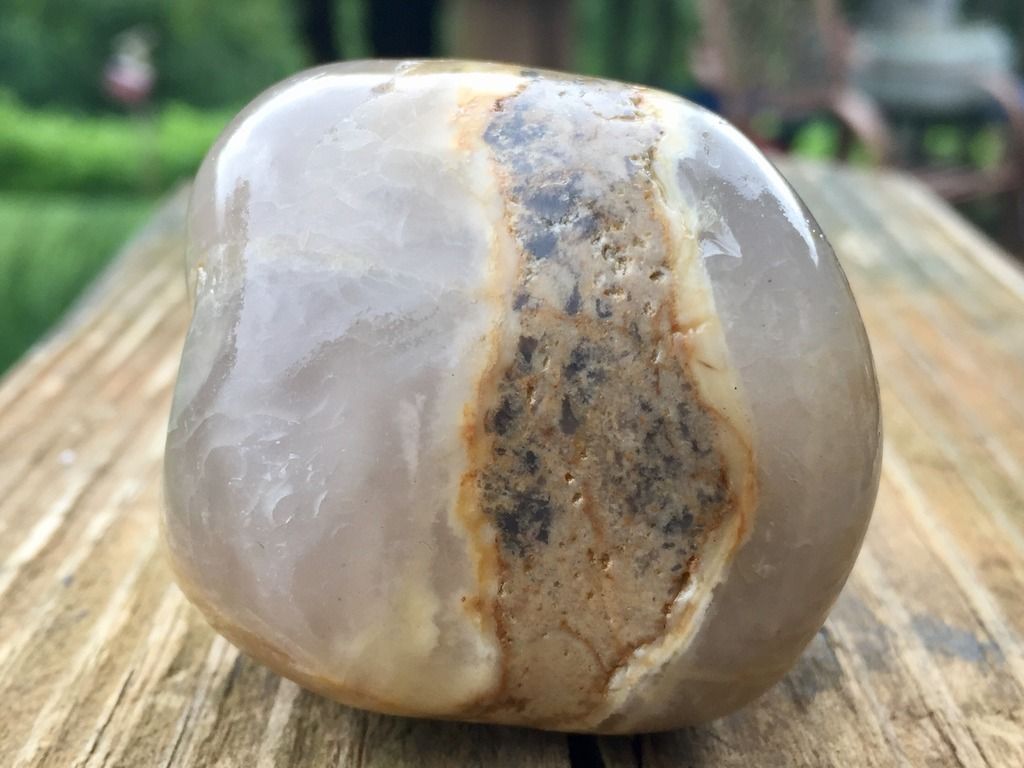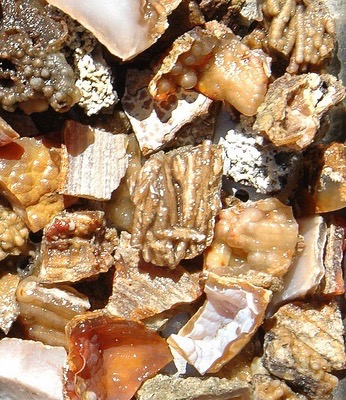|
|
Post by MrMike on Jun 8, 2017 17:09:52 GMT -5
Any ideas how an agate like this would form? Sabre52, 1dave, ?  |
|
|
|
Post by fernwood on Jun 8, 2017 17:46:21 GMT -5
I am finding a lot of similar looking ones and am a little curious as well.
|
|
|
|
Post by woodman on Jun 8, 2017 20:15:27 GMT -5
I think most if not all agates form in a pocket or hole in the ground. sometime those pockets are not entirely empty and this is what you get.
|
|
|
|
Post by 1dave on Jun 9, 2017 0:36:47 GMT -5
Yes, openings in the ground get filled by rhythmic crystallization from the exterior to the interior as happens in fortification agate. You can often follow the progression from empty hollow to last layer to be formed in what becomes the center.  |
|
Deleted
Deleted Member
Member since January 1970
Posts: 0
|
Post by Deleted on Jun 15, 2017 9:51:22 GMT -5
Yes, openings in the ground get filled by rhythmic crystallization from the exterior to the interior as happens in fortification agate. You can often follow the progression from empty hollow to last layer to be formed in what becomes the center.  Thanks Dave!! That's great for layered agates. How do you explain the massive agates like Florida coral? Huge boulders full of non layered agate. And wouldn't jamesp corals more correctly be flint? |
|
jamesp
Cave Dweller 
Member since October 2012
Posts: 36,612
|
Post by jamesp on Jun 15, 2017 10:34:49 GMT -5
Yes, openings in the ground get filled by rhythmic crystallization from the exterior to the interior as happens in fortification agate. You can often follow the progression from empty hollow to last layer to be formed in what becomes the center.  Thanks Dave!! That's great for layered agates. How do you explain the massive agates like Florida coral? Huge boulders full of non layered agate. And wouldn't jamesp corals more correctly be flint? SE US coral is silicified by mineralized water, just like chert. Chert is often full of fossils, coral no different, just a big fossil and receptor of silica rich water Coral dense and hard like chert. Root holes(casts), clam holes(casts), death plate(chert) all are found hand in hand with coral. Same cast material. Some coral cast, some replaced, some are hybrid. Indonesian coral replaced much better than SE US coral. So the corallite preservation. Chert is mined for highway gravel in Florida. A quarry will have 20 foot boulders of dead pure (not-so-pretty) chert. Chert deposits are massive in thickness. They blast and crush those big boulders into road gravel. They are glassy enough to be very vulnerable to dynamite. Much of it chips/breaks conchoidal. and it is wet inside. Wet enough that fire will make it fracture to little pieces and fragments. Takes a year in a greenhouse to dry it out when the size of a brick. Longer for soccer ball size. Many of the gravel roads in central Florida are paved in a boring devil's toenails type chert gravel. Very fossiliferous. Some coral locations have iron deposits effecting the color. Most do not. I think the salt dissolved a lot of the iron as you move into Florida. Lots of Georgia coral is stained on the outer layer from iron, Iron from iron rich clay that washed down from the Appalachians. Most coral and chert down south has never seen a freeze, protected by ground warmth or rivers. |
|
|
|
Post by 1dave on Jun 15, 2017 10:41:24 GMT -5
@shotgunner Interesting questions.
Right now I am rethinking the agate question. Massive quartz crystal masses found with those corals and the filling of Brazilian cathedral agates at temperatures around 50oC don't mesh with my research from the 50's and 60's.
As warm water infiltrated into the Cathedrals and converted basalt into celadonite, they released sodium and potassium. IF they developed separate jells that rhythmically converted to agate that would account for rapid accumulation of layers.
|
|
Deleted
Deleted Member
Member since January 1970
Posts: 0
|
Post by Deleted on Jun 15, 2017 11:53:50 GMT -5
|
|
jamesp
Cave Dweller 
Member since October 2012
Posts: 36,612
|
Post by jamesp on Jun 15, 2017 12:32:16 GMT -5
There is theory that the ridge going down central Florida where the coral grew is a rim of a meteor impact creating the gulf Of Mexico.
Never found any shocked coral, rim first, then a hot age high ocean, then the coral formed.
Something about that coral is a rare formation. So the geologists say, can't remember now.
|
|
jamesp
Cave Dweller 
Member since October 2012
Posts: 36,612
|
Post by jamesp on Jun 15, 2017 13:25:27 GMT -5
Be aware that those corals have silica coatings in 2 and 3 different positions of level. Cracked out debris that fell to the bottom of the cavity and then got coated. Then debris is coated on the side of the cavity. Gravity coated. Gravity had a big effect on the silica forming. Silica was being deposited for ages, even when the cavity was rotated a bit. Makes you wonder if the coating process is active this day. no one comments on this phenom in the geo world. This messes with me. the tubes in coral are coated in silica. The tubes are always parallel in nature. These tubes are broken off and recoated, note they are not parallel - center photo and upper right photo.  |
|